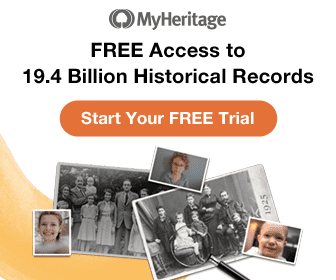By now, most family historians have heard the big news- the 1950 United States Federal Census is going to be released in the spring of 2022! This record set will be a huge benefit to genealogists researching families in the mid-20th century. But there are some things you’ll need to know in order to utilize the 1950 census data to your advantage. Here we’ll answer some frequently asked questions, and include some helpful web links to help you make the most of this exciting new resource!
Is the 1950 census available?
1950 census data is already available- but it doesn’t include any specific personal information for the individuals that were enumerated.
The 1950 U.S. census data was collected as of April 1st, 1950. Even if the enumerator visited later, residents were instructed to provide information as of that date. The main goal of the census was to determine the population of the United States, but enumerators were also instructed to obtain additional data about the residents they encountered. Additional information collected in 1950 included:
- Home address and whether the house is on a farm
- Name and relationship to head of household
- Gender
- Age
- Race
- Marital status
- Place of birth
- If foreign-born, whether the resident was naturalized
- Employment status and hours worked, along with additional information about occupation
Aggregated data from this collected information is called “microdata,” and can currently be viewed on the IPUMS USA website (Integrated Public Use Microdata Series). The 1950 census microdata is useful for statistical research- for example, tracking population growth in a certain area- but you will not be able to locate a specific ancestor’s information within the data sets. See more 1950 census statistics.
When is the 1950 census release?
The 1950 U.S. Census will be available to the public on Friday, April 1st, 2022- and that’s not an April Fools’ joke! On this date, digitized images of the original census pages will be available to view. They will look very similar to the 1940 census records, which are already available for research on sites such as Ancestry or Family Search.
Like previous census records, the 1950 census images will contain specific information about the individuals residing in each household visited by the enumerators.
The National Archives and Records Administration (NARA) recently created a special 1950 Census Records page that includes a “Countdown to the 1950 Census Launch” clock, and all the latest news about the upcoming release.. Be sure to bookmark this page and visit often!
Why is the 1950 census not available yet?
Census records are withheld from public viewing for 72 years due to a rule enacted by the U.S. government, which attempts to respect the privacy of the individuals listed on the records. April 1st, 2022, will be 72 years to the day that the 1950 census was recorded. The National Archives’ blog provides a great history of the 72-year rule.
How do I access the 1950 census?
NARA announced that they have partnered with Amazon Web Services (AWS) to host the 1950 census images on a dedicated website. You will be able to view individual images, or even do a “bulk download” of the entire dataset. Watch NARA’s 1950 census page for more updates.
The 1950 census records may not be available on other genealogy sites right away. However, a few of the “big” companies have released news related to the 1950 census:
- Similar to indexing projects created during the 1940 census release, FamilySearch is planning a major “1950 US Census Community Project” to help verify and correct the initial 1950 census index information.
- According to FamilySearch, Ancestry will be creating the “computer-generated index” that volunteers can help correct and verify. Ancestry promises that the 1950 Census will be available on their website sometime in 2022.
- MyHeritage will be offering “much more advanced search capabilities” once the census has been fully indexed.
How do I find someone in the 1950 census?
NARA has confirmed that AWS will use a special “artificial intelligence/optical character recognition” tool to read and extract names from the 1950 census. So there will be an initial, rough index, but it will not be perfect. The good news is you can use other resources to locate your ancestors if they do not appear in the initial index. Here are some online finding aids for the 1950 census:
How to Access the 1950 Census in One Step
Steve Morse and Joel D Weintraub have created a helpful tutorial/quiz to help you locate the enumeration district of your family’s home. You can then use the enumeration district number to locate the particular 1950 census pages where your ancestor should be listed.
Finding Aids for the 1950 Census
NARA’s 1950 Census page also includes a link to a list of finding aids, including enumeration district maps (with instructions on how to use them), plus a list of more 1950 census search engines from Stephen Morse!
Additionally, Joel Weintraub has created a YouTube video, “1950 Census Location Search Tools”, which covers a variety of helpful tools and resources.
What were the 1950 census questions?
The 1950 census included similar questions to the 1940 census. Employment information was a main focus. Unfortunately, while the 1940 census indicated who provided information to the enumerator, there is no such indication on the 1950 census. Similar to 1940, several people on each census page were selected to answer supplemental questions, about their residence in the previous year, parents’ place of birth, education level, employment duration, wages and income, and military service. (NGS Magazine, Vol. 48, Number 1, Jan-March 2022). Here are some good resources that cover the 1950 census questions.
- NARA’s 1950 Census page provides a full list of the questions asked on the census.
- You can also find the list on the U.S Census website along with other census information.
- NARA’s HistoryHub blog provides a great comparison of the 1950 census and 1940 census.
- The FamilySearch Blog also provides a great breakdown of the 1950 Census questions.
Why was the citizenship question removed from the census after 1950?
The 1950 census asks where each person was born. If someone was foreign-born, a follow-up question asks if the individual is naturalized. The answer to this second question would indicate whether the person was legally a U.S. citizen.
After the 1950 census, the Census Bureau was able to utilize new computer technology to collect statistical data. They analyzed previous census-taking methods and decided that the citizenship question was no longer needed as part of the main census survey. Instead, this question was included on a “sample survey” that was given to a much smaller portion of the population and used for other statistical purposes. The citizenship question has not returned to the U.S. census survey in subsequent decades, although it has been a subject of political debate over the years.
Final Thoughts
The best thing genealogists who are eagerly awaiting the 1950 census release can do is to develop a research plan! Make a list of the ancestors you are looking for in the census. Write down what you know, especially the location where they lived, if you know it. Use existing records from the time period, such as newspapers and city directories, to fill in the blanks. And make sure to review the 1950 census questions and finding aids, so you know how to locate your ancestors and what kind of information you will glean from this exciting new record set!


